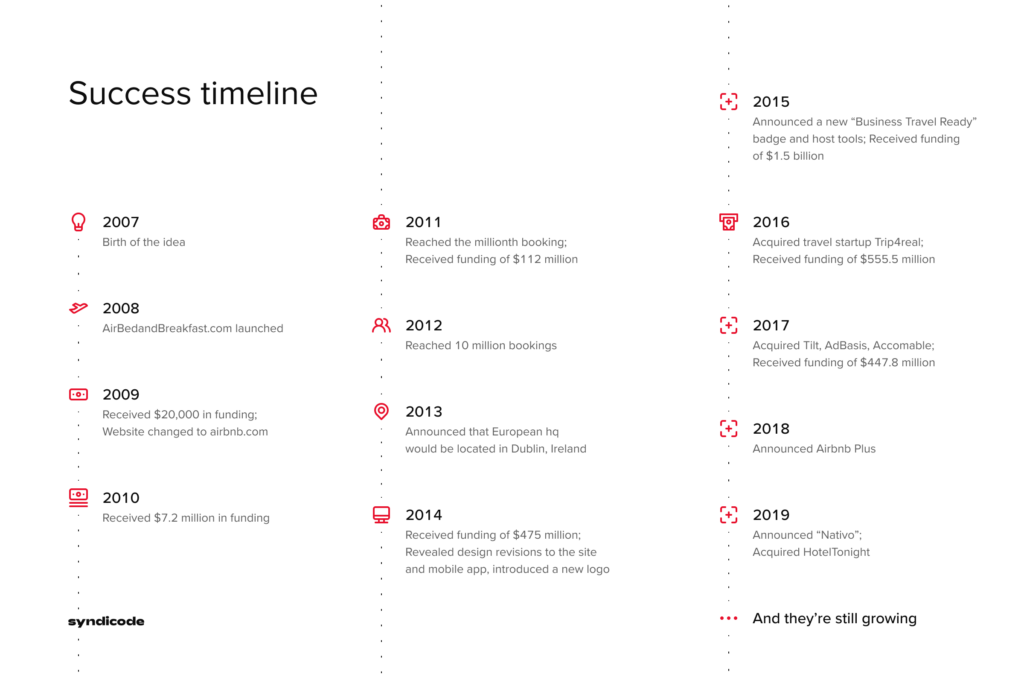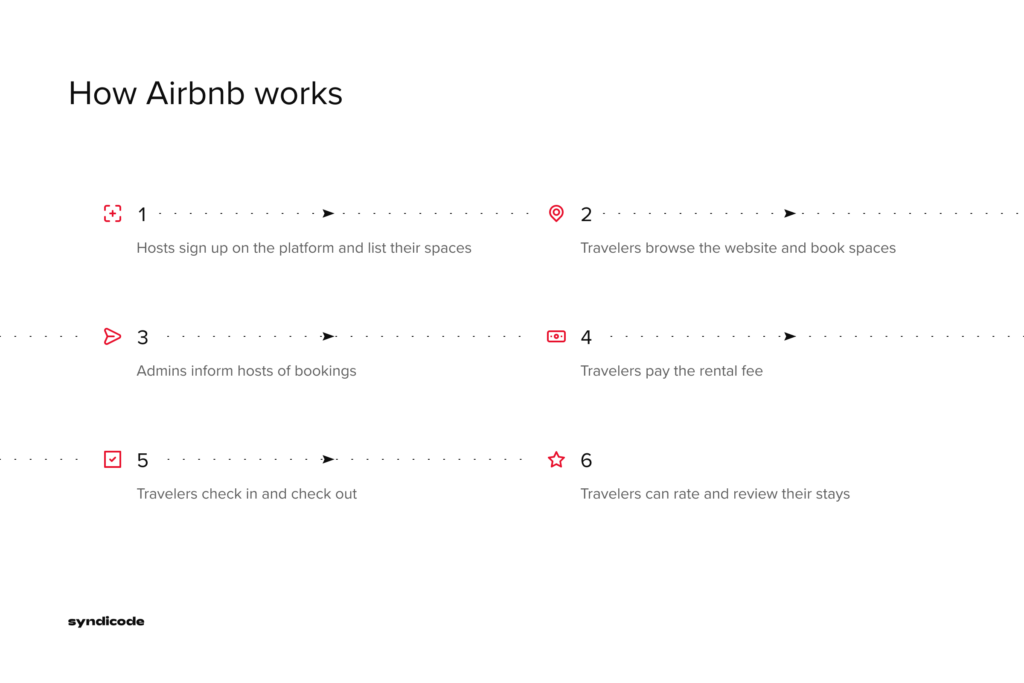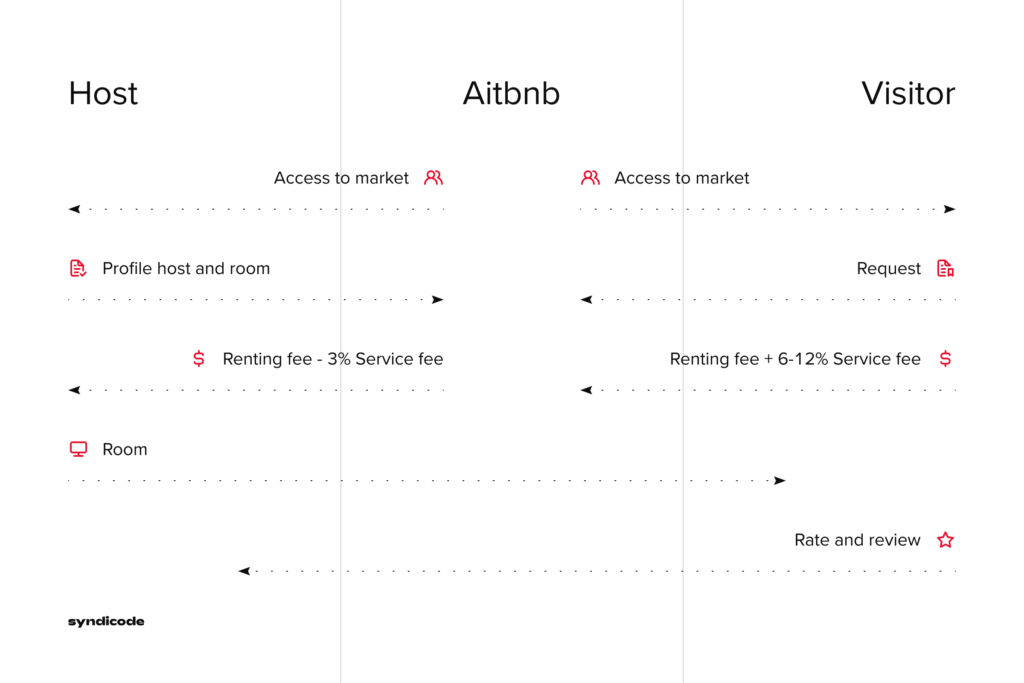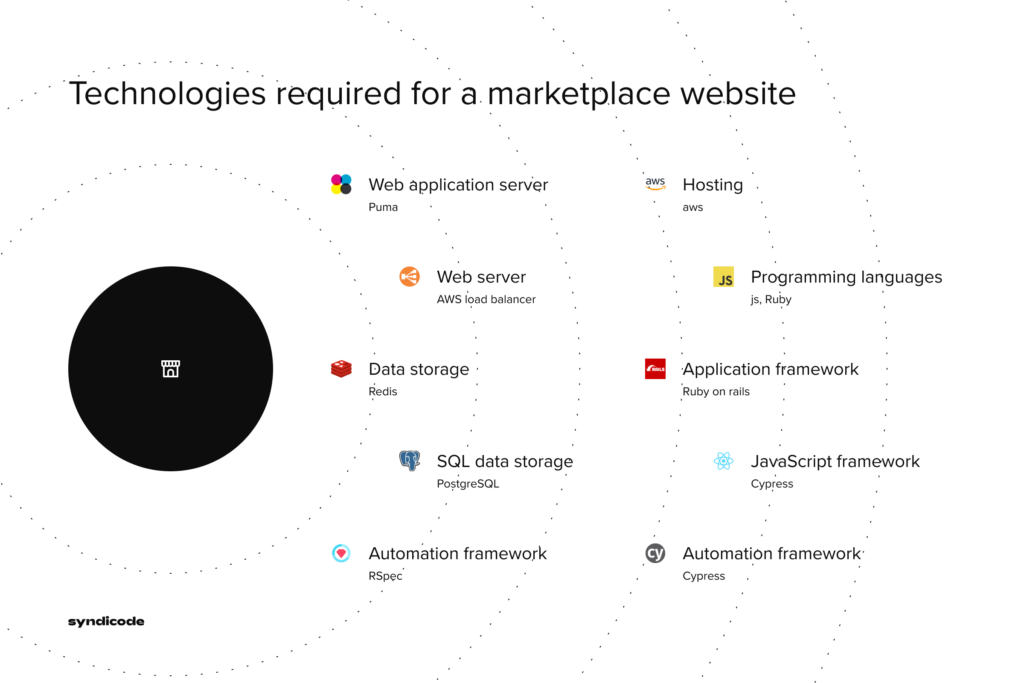What is Airbnb in the first place? It is a property-renting marketplace that gives an alternative approach to perceiving hospitality. With more than 150 million users, it’s one of the biggest peer-to-peer platforms in the world. The marketplace revolutionized hospitality: now investors purchase and renovate entire apartments only to rent them on Airbnb.
On the one hand, this success is awe-striking. Investors and business owners are eager to repeat the success of the platform and consider making similar marketplaces. On the other hand, if there’s already Airbnb 1.0, who needs a clone platform?
The key to succeeding in building an online marketplace like Airbnb is in figuring out where the original platform falls short and implementing unique features in your project.
In this article, we’ll help you figure out how to build a website like Airbnb. The platform gives us valuable lessons, but it’s not perfect. There are still open business opportunities in the niche.
Things to know about Airbnb marketplace
Airbnb is a peer-to-peer marketplace for location-based property rental.
- Users rely on location as the main search filter for listings;
- Peer-to-peer definition refers to the decentralized structure of the marketplace. There’s no third party who providers offers. Any user can both purchase and sell freely.
- The platform receives a commission from the purchases on the platform.
Rental marketplaces are different from the buying ones. Renting itself is a transition state between a purchase and a service. Although the effort of the seller is not required (which is why it’s a passive-income approach), the level of responsibility is higher than on Amazon or eBay. Sellers are expected to walk buyers through the process and provide step-by-step assistance.
From the perspective of marketplace development, this hybrid nature presents challenges. Airbnb allows sellers and buyers to interact on a regular basis, participate in community discussions, leave detailed reviews, and consult other users. The selection process is much more intricate than on Amazon.
There’s good news, though. Because Airbnb is already highly established, users are accustomed to trust rental platforms. Business owners can ride the hype wave, stirred by Airbnb, and use it to set their platforms afloat. For the team behind the original marketplace, the starting process was much harder – users were reasonably skeptical about living in strangers’ apartments or letting someone live in theirs.
The brief history of Airbnb

A lot of entrepreneurs heard the basic gist of the story. Joe Gebbia and Brian Chesky, roommates at the time, decided to make extra cash by letting other people stay in their apartment. At first, this was just a way to make a few bucks to spare. However, when they saw how high the demand was, they understood the scaling potential of the business. So, the two built the Airbnb website to promote their apartment. Shortly after, they allowed other owners to advertise their property.
The main challenge of Airbnb growth was to build trust. The founder, Joe Gebbia has an entire Ted Talk about building trust between people. In particular, he asked the audience to pass their phones to strangers, and demonstrated ways to increase the trust for this risky enterprise.
Joe Gebbia focused on providing information. He says that if a stranger introduced himself, showed personal photos, told the names of wife, kids, and dog or backed his reputation with hundreds of reviews, we would be much more open to entrusting our phones.
What is the value of Airbnb?
Airbnb leverages user trust with three key values:
- Safety: the marketplace has a tried-and-proven system for running background checks, monitoring reviews, and using machine learning to detect potentially deceitful offers. The team communicates with sellers and buyers and checks the validity of personal information. Payments are protected according to international guidelines.
- Connection: every user is required to provide personal information and prove it with an official ID. The Airbnb marketplace has a built-in messenger and a review system. The community is open for discussions – buyers and sellers can share their warnings about shady profiles.
- Support: Airbnb has a 24/7 support team with assistants who speak 11 languages. They also have long-running onboarding programs, a Million Dollar Host Guarantee policy, and insurance plans. The system doesn’t prioritize buyers over sellers: both parties are equally protected by the team.
If you are building a rental marketplace, taking a page from Airbnb’s book is a good start. On the organizational level, this means establishing support teams, selecting moderators, and partnering insurance providers worldwide. When the startup scales, partnerships with government authorities and legal firms are another crucial step.
Rental marketplace business models
Principles, applied by Airbnb, are crucial for all kinds of rental. You don’t have to limit yourself to houses and apartments – anything can be listed, from pools to musical instruments. So, if you don’t yet have a clear idea of what kind of rental business you’d like to start, we might pitch in with some.
Party rentals
A marketplace that rents venues for parties and business meetings. The listing range is almost unlimited – you can talk about offices, cafes, apartments, houses, and even yachts. The only condition is, the owner of the venue approves of a party program and is ready to prepare the property.
How is it different from a typical rental?
- Not every property owner is down to having a party on their premises. Neighbors might complain about loud music, plus, property damage is always a risk. However, those who have suitable conditions for partying might be able to make dozens or hundreds of bucks by renting their apartment or house for a night.
- Preparing a venue for a party takes a lot of time. What if a group of friends wants to arrive at a venue that’s already well decorated, clean, and full of good vibes? That’s where your party marketplace can cover this need and offer a party-ready venue.
- Every event has different requirements. Most party handling marketplaces limit themselves only to very particular types of parties. Some are focused on children’s birthdays, others – on business meetings. What if you were to look at the bigger picture and broaden the offer? This way, you’d cater to the needs of many users and open scaling opportunities.
How does Airbnb work?
Both in the web and mobile versions of Airbnb, we can consider the user flow and all the ways in which the marketplace interacts with the client. Another aspect to take into account is the underlying infrastructure – data structure, server APIs, and the software architecture.
Let’s dive in.

User flows at Airbnb
As one of the most elaborate rental marketplaces out there, the platform covers hundreds of features. They can be roughly divided into 20-30 major flows in the Airbnb website design – the main paths that users follow on the platform:
- Publishing a property listing on Airbnb. The journey starts with a button “Become a host”, and goes to Start hosting – Steps (an explanatory page) – Sign up (the key action) – Property description – Details – Listing approval.
- Onboarding on Airbnb. Both on mobile and web versions users start from the Sign Up button, confirm that they are not robots, agree to terms, and fill out the profile. It’s one of the shortest and clearest onboarding journeys out there.
- Booking property on Airbnb. As a core flow of the marketplace, it’s the most elaborate one (10+ steps). The key landing points are Home – Set location – Select dates – Set guests – Rules – Room Reservation – Order Processing – Completion.
- Searching for the property. The key filters are dates and locations – to see the listed offers, users should specify the details of their stay. Additional parameters include reviews, price, number of rooms, address. The search page collects links to property offers and redirects to the rental description.
- Inviting people to the marketplace. Referral programs are by far the most cost-effective way of getting new users. Airbnb allows sharing the service with just three buttons – Invite friends, Share, and Choose invite email. For referring users, members earn “Travel Credits” – discount points for future bookings.
- Leaving reviews. First, users give an overall review of their stay at a rental on a 5-star scale. Then, the Airbnb platform zooms in on specifics, asking tenants to rate the cleanliness of the property, ease of check-in, smoothness of communication, transportation convenience, and other important aspects of a good stay. Also, Airbnb users can leave notes to show their gratitude to the landlord or warn others about the negative experience.
Key features
Airbnb is a good example of an on-demand app that knows the needs of its target audience to a tee. The development team made sure that the marketplace has no redundant features (else it’ll be too hard to use), is fast (so that it runs even on slow networks) and secure (there’s a system of account verification that protects both landlords and tenants).
How does Airbnb check all these boxes? Let’s take a look at the platform’s signature features:
- Same-day rental listings. Airbnb created a search filter for tenants who want to book an accommodation and check in immediately. It’s a handy feature that helps users sort through listings and connect with owners who accept same-day bookings.
- Saving good offers as “Favorites”. Shortlisting property is not easy since a lot of criteria (price, location, size, infrastructure) come into play. That’s why future tenants might want to save listings and compare them side-by-side to make an informed choice. To that end, Airbnb allows creating a collection of favorite accommodations to make sure users don’t lose good offers.
- Planning trips in teams. Airbnb does a good job at catering to friend groups, families, and work teams planning a get-together. By letting groups share trips and access the itinerary in real time, the platform saves everyone involved a lot of time and effort in streamlining communication, sharing screenshots, and making spreadsheets to keep decision-makers in the loop.
- In-app messenger. The developers of airbnb type websites need to give tenants and property owners a way to connect and make agreements via the marketplace. In the original app, there’s a built-in messenger that connects accommodation seekers and landlords. For anti-spam protection, the platform has daily message limits – users can send up to 25 texts in 24 hours.
- Alerts and notifications. Booking an accommodation and planning a trip involves responsible decision-making. That’s why rental platforms should support users through accountability-enforcing features. In the case of Airbnb, these are real-time notifications and alerts. Via pop-ups and emails, the platform updates users if there are changes of plans on the other side. Also, Airbnb uses notifications to share top offers with the community.
Revenue model
Airbnb makes money by charging two sides commissions for each transaction, namely:
- 6-12% transaction fee for guests who booked an accommodation.
- 3% transaction fee for homeowners after a booking is confirmed.

Goals and development vectors
As a marketplace, Airbnb prioritizes scalability. Unlike most large players in the industry (e.g. hotel chains like Hilton or Marriott), the platform is infinitely scalable as it doesn’t depend on the capacity of physical facilities.
High scalability potential is the key reason why the Airbnb business model is referred to as exponential.
Other than scalability, the development team focuses on:
- Openness and collaboration. Airbnb enforces these ideas both through features that promote transparency (tenants and landlords should fill in a profile to be trustworthy, all deals are tracked, reviews help shed light on a landlord’s reliability) and internally – through corporate culture by introducing a horizontal hierarchy and encouraging discussions at offices.
- Personal involvement. The company focuses on building an engaged user community by staying in touch with users via social media and helping tenants and landlords connect via reviews and in-app messaging.
How to Build a Marketplace like Airbnb
Building a complex marketplace like Airbnb is intimidating at the first glance – however, once broken down into actionable steps, the process gets manageable and straightforward.
Here’s a step-by-step guide that covers how to develop a website like Airbnb.
Choose the software development strategy
There are two approaches to building a rental marketplace like Airbnb: designing a generic platform via a solution that enables marketplace development and building a custom product from scratch.
Here’s a closer look at the benefits and drawbacks of each strategy.
Building a rental platform on marketplace with ready-made solutions
Off-the-shelf platforms like Shopify, Sharetribe, and others save developers a lot of time. They support developers with a scalable infrastructure and interface templates, customizable in a matter of days.
On the flipside, there’s a limit to the customizability of ready-to-deploy marketplaces. The infrastructure might not support unique features and bold technical choices.
Also, building a rental platform on Shopify or Sharetribe makes developers reliant on a third-party infrastructure.
That presents a variety of security concerns, especially since an online marketplace like Airbnb stores sensitive data (addresses, credit card numbers, etc.) and will require a higher degree of protection than that supported by off-the-shelf solutions.
Custom marketplace development
A different way to get a rental marketplace off the ground is by building a platform from scratch. This way, the development team has full control over data protection and resource usage, doesn’t have to pay fees for resource usage, slowing down scalability, and has no constraints in releasing unique creative features.
Naturally, there are considerations to custom marketplace development. For one, it’s a slower process since you need to hire a skilled tech team, choose a tech stack, and build an infrastructure from scratch, component by component.
Also, in the early stages of the marketplace lifecycle, maintaining the infrastructure in-house is more expensive than relying on a vendor-based setup. As the platform scales, however, custom development becomes more cost-efficient than using ready-made solutions that have exponential fees.
What technology stack is needed for a website like Airbnb?

Determining a tech stack for the project is an impactful decision since it sets a direction for hiring campaigns, affects the time needed to complete the project, and puts scalability and performance constraints on the final build.
Airbnb is a complex marketplace with high scalability demands that stem from the platform’s 150 million user base. As a result, the development team relies on a robust tech stack.
Here’s the list of technologies the platform uses for sustenance:
- Programming languages: JS and Ruby.
- Frameworks: Ruby on Rails (high development speed and reduced costs), ReactJS for building flexible user interfaces.
- Web server: Nginx (for faster content delivery and improved security). It’s a scalable proxy server, deployed by other tech giants as well (e.g. Netflix and Zappos).
- Key-value database for ensuring a scalable infrastructure: Redis.
- Cloud storage for user data: Amazon S3.
- Cloud hosting for reducing system downtime: Amazon EC2.
- Big data tools for processing information and gathering valuable insights: Airpal, Presto.
Smaller-scale marketplace developers can settle on a narrower range of technologies. For Airbnb, the key component of the infrastructure is Ruby on Rails, superior in performance, affordable costs,and time to market.
Make a full list of features
An Airbnb-like platform has a robust feature set – to make sure you don’t miss out on key functionality, group all tools in three categories:
- Tenant-facing features: functionality that facilitates property search, builds trust in the landlord, and helps communicate with property owners.
- Host-facing features: publishing listings, managing booking requests, and getting on-time payments from tenants.
- Extra features – unique tools that set the rental marketplace apart from other platforms on the market.
Here’s an example of a full feature breakdown for an Airbnb-like marketplace:
| Tenant-facing features | Owner-facing features | Extra features |
| Search and filters to sort through listings | Listing properties by filling in a precise form | 360-degree property tours |
| A detailed description of each property | Vetting and connecting with prospective tenants | Comparing accommodations |
| Adding properties to the waitlist or saving them as “Favorites” | Adjusting payment details | Security encryption of user data |
| Managing upcoming reservations | Accepting or declining booking requests | Advanced search filtering |
| Getting notifications and real-time alerts from the platform | Accepting payments | |
| Reviewing a stay and viewing the feedback of other users | Updating tenants on price and availability | |
| Compensating property owners via a preferred payment method | Promoting listings in search rankings via sponsored programs | |
| Messaging hosts | ||
| Filling in a personal profile |
You can also read: How to Build a Job Search Website
Build an MVP
Before you commit to developing a rental marketplace, tech teams should validate their idea and estimate accurate development costs and timeline. The most common way to do it is by developing a minimum viable product – the basic version of the platform.
Here’s a step-by-step guide to building an MVP:
- Build design processes and user flows: signing up, listing properties, finding accommodation, making payments, messaging a homeowner/tenant, etc.
- List and implement key features: sign up, filtering and search, a feed of available properties including the “Recommendations” reel tailored to a user’s on-site experience, the detailed description of a property, contacting a vendor, making a payment, etc.
- Build the interface following basic design and performance principles: intuitive navigation, mobile responsiveness, cross-platform availability, consistency, and others.
- Test the MVP against a user group to get extra insights, add new features, improve the interface, or strengthen the security of the platform.
Build the full product
Once you process MVP testing insights, align the main features and the vision for the interface, the development team takes over and works on the product that will be shipped to the end user.
At Syndicode, we break the marketplace development workflow down into five stages:
- Building the back-end for the platform’s core features.
- Creating a UI/UX interface.
- Testing functionality.
- Validating performance
- Launch and maintenance.
How Much a Website like Airbnb Costs
To see how much time and resources you need to develop an up-and-running platform, take a look at our feature-by-feature breakdown based on the experience of Syndicode developers in marketplace development.
| Feature | Time (hours) |
|---|---|
| UX/UI | 42 |
| User profiles | 42 |
| Search and property filtering | 96 |
| Property page | 42 |
| In-app messaging | 32 |
| Payments | 42 |
| Reviews | 48 |
| Alerts and notifications | 32 |
| Booking management (for guests) | 82 |
| Booking management (for hosts) | 84 |
| Admin panel | 96 |
| Geolocation | 32 |
| Security | 72 |
| Total | 742 |
This is an estimate, not a definite cost and development timeline. Depending on the complexity and scale of your future projects, these values can fluctuate downward or upward.
Conclusion
Building a rental marketplace is a sensible idea from multiple perspectives. For one, you don’t need to own property to get started since your platform will be a bridge between homeowners and tenants. Also, unlike businesses tight to physical commodities, a market place has an infinite scalability threshold.
If you are committed to building a rental platform like Airbnb, reliable and easy-to-use tech infrastructure should be a priority. Since you offer no goods or services yourself, intuitive UI and a wide range of features is the only way to attract both property owners and accommodation-seekers.
To build a scalable and intuitive marketplace, reach out to Syndicode. Our developers are specialized in creating custom marketplaces that run on Ruby on Rails. The team prioritizes performance, loading speed, security, and quick delivery to market
To see our attention to detail and emphasis on ease of use in action, take a look at the projects our team completed. If you have an idea for a rental platform and want to discuss it with experienced developers, let’s get in touch!
